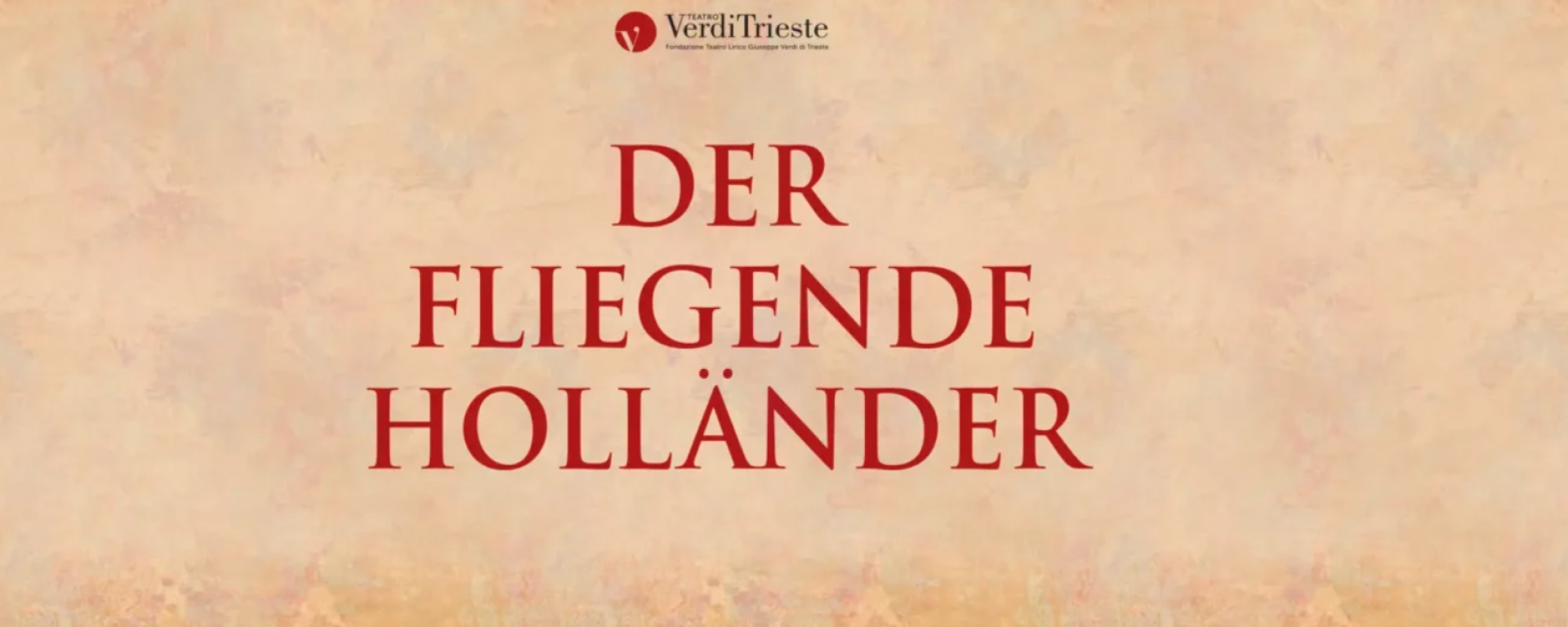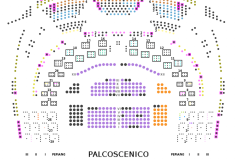The Flying Dutchman
March 2025 | ||||||
|---|---|---|---|---|---|---|
Mo | Tu | We | Th | Fr | Sa | Su |
OPERA AND BALLET SEASON 2024-25
Der Fliegende Holländer
Opera by Richard Wagner
Synopsis
Place: On the coast of Norway
Act 1
On his homeward journey, the sea captain Daland is compelled by stormy weather to seek a port of refuge near Sandwike in southern Norway. He leaves the helmsman on watch and he and the sailors retire. (Song of the helmsman: "Mit Gewitter und Sturm aus fernem Meer" – "With tempest and storm on distant seas.") The helmsman falls asleep. A ghostly vessel appearing astern is dashed against Daland's vessel by the sea and the grappling irons hold the two ships together. Invisible hands furl the sails. A man of pale aspect, dressed in black, his face framed by a thick black beard, steps ashore. He laments his fate. (Aria: "Die Frist ist um, und abermals verstrichen sind sieben Jahr" – "The time has come and seven years have again elapsed") Because he once invoked Satan, the ghost captain is cursed to roam the sea forever without rest. An angel brought to him the terms of his redemption: Every seven years the waves will cast him upon the shore; if he can find a wife who will be true to him he will be released from his curse.
Daland wakes up and meets the stranger. The stranger hears that Daland has an unmarried daughter named Senta, and he asks for her hand in marriage, offering a chest of treasure as a gift. Tempted by gold, Daland agrees to the marriage. The southwind blows and both vessels set sail for Daland's home.
Act 2
A group of local girls are singing and spinning in Daland's house. (Spinning chorus: "Summ und brumm, du gutes Rädchen" – "Whir and whirl, good wheel") Senta, Daland's daughter, dreamily gazes upon a gorgeous picture of the legendary Dutchman that hangs from the wall; she desires to save him. Against the will of her nurse, she sings to her friends the story of the Dutchman (Ballad with the Leitmotiv), how Satan heard him swear and took him at his word. She vows to save him by her fidelity.
The huntsman Erik, Senta's former boyfriend, arrives and hears her; the girls depart, and the huntsman, who loves the maiden, warns her, telling her of his dream, in which Daland returned with a mysterious stranger, who carried her off to sea. She listens with delight, and Erik leaves in despair.
Daland arrives with the stranger; he and Senta stand gazing at each other in silence. Daland is scarcely noticed by his daughter, even when he presents his guest as her betrothed. In the following duet, which closes the act, Senta swears to be true till death.
Act 3
Later in the evening, the local girls bring Daland's men food and drink. They invite the crew of the strange vessel to join in the merry-making, but in vain. The girls retire in wonder; ghostly forms appear at work upon the vessel, and Daland's men retreat in fear.
Senta arrives, followed by Erik, who reproves her for deserting him, as she had formerly loved him and vowed constancy. When the stranger, who has been listening, hears these words, he is overwhelmed with despair, as he thinks he is now forever lost. He summons his men, tells Senta of the curse, and to the consternation of Daland and his crew declares that he is "Der fliegende Holländer."
As the Dutchman sets sail, Senta throws herself into the sea, claiming that she will be faithful to him unto death. This is his salvation. The spectral ship disappears, and Senta and the Dutchman are seen ascending to heaven.
Program and cast
Conductor: ENRICO CALESSO
Director: HENNING BROCKHAUS
Set designer: ALFONS FLORES
Costume designer: GIANCARLO COLIS
NEW PRODUCTION BY FONDAZIONE TEATRO LIRICO GIUSEPPE VERDI DI TRIESTE
Cast
Der Holländer: JAMES RUTHERFORD
Erik: CLAY HILLEY
Senta: ELENA BATOUKOVA
Daland: ALBERT DOHMEN
Choir Master: PAOLO LONGO
ORCHESTRA, CHOIR AND TECHNICIANS BY FONDAZIONE TEATRO LIRICO GIUSEPPE VERDI DI TRIESTE
Teatro Verdi Trieste
The Teatro Lirico Giuseppe Verdi is an opera house located in Trieste, Italy and named after the composer Giuseppe Verdi. Privately constructed, it was inaugurated as the Teatro Nuovo to replace the smaller 800-seat "Cesareo Regio Teatro di San Pietro" on 21 April 1801 with a performance of Johann Simon Mayr's Ginevra di Scozia. Initially, the Nuovo had 1,400 seats. In 1821, it became known as the Teatro Grande.
By the end of the 18th century, the need for a new theatre in Trieste became evident. Its main theatre, the Teatro di San Pietro, had become increasingly inadequate and finally closed its doors in 1800. A proposal to the Austrian Chancery from Giovanni Matteo Tommasini to build a private theatre had existed since 1795 and, in June 1798, a contract was drawn up whereby annual funding would come from the municipality and Tommasini would hold the rights to several boxes and the rights to sell others. Gian Antonio Selva, the architect of the La Fenice in Venice, was engaged, and he designed a classic horseshoe-shaped auditorium. However, his exterior designs were considered to be too plain for the Austrians who then engaged another architect, Matteo Pertsch, to solve the problem, which was accomplished by incorporating elements of Milan's La Scala opera house. The "Nuovo" became a mixture of La Fenice on the inside and La Scala on the exterior.
History
Several name changes have occurred during the theatre's lifetime, the first in 1821 when it became the Teatro Grande [1] and it was under this name that the theatre was the site of two Verdi opera premieres: Il corsaro in 1848 (featuring the soprano Giuseppina Strepponi, who Verdi married in 1859, in the leading role) and Stiffelio, a production which Verdi supervised - not without controversy - in 1850.[2] However, before these premieres, Verdi's operas had begun to dominate the Teatro Grande's stage, followed, as the century progressed, by all the major works of the opera repertoire, including those by Puccini and Wagner.
A further name change followed in 1861 due to a change from private to public ownership. Thus it became the Teatro Comunale and existed as such throughout the latter years of the 19th century. By 1881, seating capacity had been increased to 2,000 through the use of existing standing room spaces; but, by that December, the theatre was declared to be unsafe and it was closed for renovations, during which electricity replaced gas lighting for the reopening in 1889 with 1,000 seats.
Within hours of his death in January 1901,[3] the theatre was once again renamed, this time to honour the memory of Giuseppe Verdi. It was extensively restored between 1992 and 1997 and re-opened with about 1,300 seats[4] and with a Viva Verdi concert[3] which included excerpts from many of the composer's operas. (Like the restoration of La Scala between 2001 and 2004, a temporary alternative venue was quickly created in Trieste and the Sala Tripcovich continues to offer space for chamber opera and operettas.)
A major feature of the Teatro Verdi's programming in the past 40 years, which stems from the original Austrian occupation of the city in the 19th century and the fact that Trieste did not become part of Italy until 1918, is the "International Festival of Operetta" which takes place every summer.
Premieres
The theatre has seen the world premieres of the following operas:
Ginevra di Scozia by Simon Mayr, 21 April 1801
Annibale in Capua by Antonio Salieri 20 May 1801
Ricciarda di Edimburgo by Cesare Pugni, 29 September 1832.
Enrico II by Otto Nicolai, 26 November 1839
Il corsaro by Giuseppe Verdi, 25 October 1848
Stiffelio by Giuseppe Verdi, 16 November 1850
Nozze istriane by Antonio Smareglia, 28 March 1895

 EN
EN DE
DE IT
IT FR
FR ES
ES RU
RU JP
JP RO
RO
 Seating plan
Seating plan 